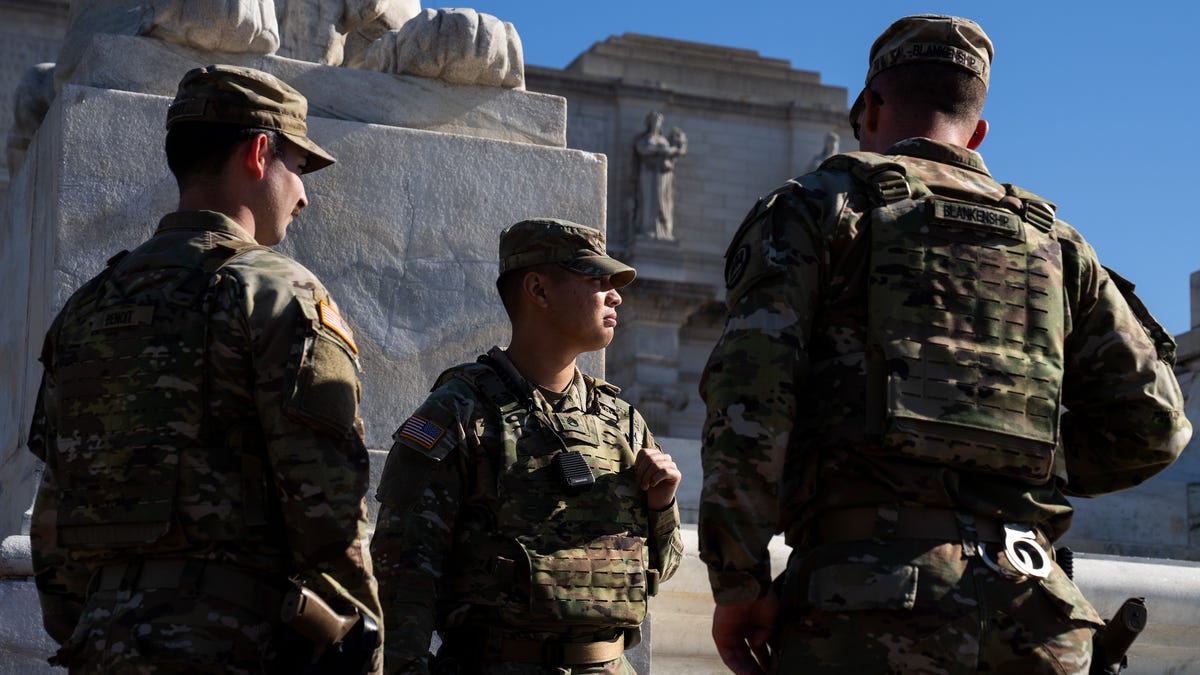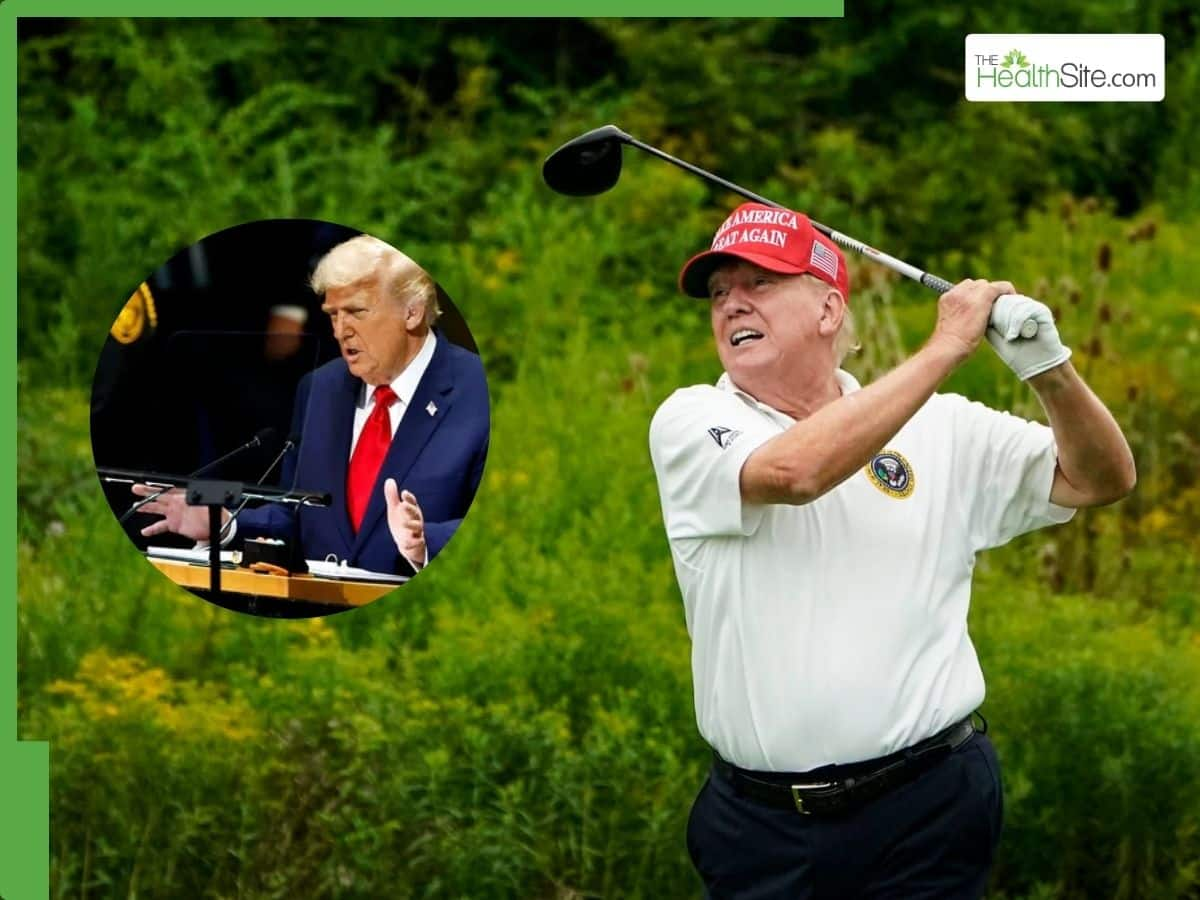Finance
How to prevent burnout and financial stress when caring for an elderly parent or relative

An estimated 48 million Americans are caring for someone over the age of 18. Many of them are family members caring for an elderly parent or older relative — and the value of that unpaid care is estimated at about $600 billion dollars a year, according to a recent report by AARP.
Daphne Taylor, Debbie Taylor and Shelia Miller know the cost of caregiving firsthand. These sisters started caring for their 87-year-old mother after she had a stroke four years ago. Coincidently, the three had all retired around that same time. Miller and Debbie Taylor live in Alexandria, Virginia, while Daphne Taylor resides in Washington, D.C.
“We started out saying, ‘Okay, this is our life now,’ and we’ll do trial and error,” said Debbie Taylor, now 63, recalling how the sisters stepped in to provide around-the-clock care to keep their mother at home.
“It was all a learning process,” said Daphne Taylor, 65, a retired project manager. She took the lead in creating spreadsheets to coordinate care, track medications and note her mom’s progress. She says the ups and downs of her mother’s health and coordinating necessary services has been frustrating. “I was always able to get done what needed to be done in the working world,” Daphne said.
Sisters Shelia Miller, Debbie Taylor and Daphne Taylor of the Washington, D.C., area care for their mother, Ernestine Taylor.
Managing health-related and long-term care expenses is also a challenge. Trying to arrange care quickly and efficiently, the sisters have paid out-of-pocket for medical equipment, transportation and supplies that were not covered by Medicare or insurance, including a $5,000 hospital bed.
“We’re trying to take care of our mom 24/7,” Debbie said. “There’s just no way in the world that you have time to try and figure this all out.”
The alternatives to being the primary caregivers for their mom are also expensive. The median cost for a private room in a nursing home is more than $100,000 a year — and more than $60,000 a year for a home health aide, according to a Genworth survey.
More from Personal Finance:
This age cohort is handling increased longevity the worst
Household debt is high but was worse in 2008, report finds
3 steps can help cover rising higher education costs
Meanwhile, family caregivers spend more than a quarter of their annual income on caregiving costs, according to a 2021 AARP report. Many of them have stopped saving money or taken on more debt to pay for those expenses.
Planning ahead for long-term care can reduce some of the financial strain, says certified financial planner and CNBC FA Council member Barry Glassman, but few families actually do it. “It’s tough because a person in their 80s doesn’t really know when they may need help, or what help they may need, if at all,” said Glassman, who is president of Glassman Wealth Services, with offices in Vienna, Virginia, and North Bethesda, Maryland.
Still experts say taking these five steps can help prevent burnout and financial stress for many family caregivers.
1. Seek help from the government, non-profits
Medicare and most health insurance plans generally don’t pay for long-term care. However, if an elderly individual is eligible for Medicaid or a U.S. veteran, there’s a good chance a family member can get paid for caring for them.
Family caregivers may be able to be paid by Medicaid, depending on their state of residence. The amount of funds can vary contingent on the elderly person’s needs and the average wage paid to home health aides in that state. Go to the American Council on Aging’s website at medicaidplanningassistance.org to find out if your loved one is eligible for a Medicaid long-term care program that pays family members.
In many states, former service members can manage their own long-term care, including choosing a caregiver, who may be a family member — and their military pension can also cover caregiving costs. The U.S. Department of Veteran Affairs’ Caregiver Support Program website can provide more information on how a caregiver of a military veteran can qualify for financial assistance.
Consider getting respite care for your loved one, too. Although options for family members to get paid for caregiving are limited, you may be able to get help by paying someone else to give you a bit of a break. Check out state and federal funding, as well as private sources that may be available to help you pay for respite care on the ARCH Respite Network and Resource Center website.
Research other government health and disability programs in your state, as well as disease-specific and non-profit organizations that may offer financial resources for caregivers, on the Family Caregiving Alliance website.
2. Take advantage of tax breaks
If your elderly parent or relative lives with you and qualifies as a dependent, you may be eligible to claim them as a dependent on your federal tax return.
You can deduct medical and health-related expenses for yourself, your spouse and your dependents that exceed 7.5% of your adjusted gross income on your federal income tax return. Qualifying expenses may also include including home modifications, equipment, and transportation.
You may also qualify for a dependent care tax credit for a percentage of up to $3,000 in qualified care expenses for one person or $6,000 for two people.
3. Ask about employer benefits that can help
You may be able to save even more money by taking advantage of health savings accounts and flexible spending accounts offered by your employer — and using that money to pay for qualified medical, dental and vision expenses for a dependent.
You generally have to be enrolled in a high-deductible health insurance plan to contribute to a HSA — which allows for up to $7,750 in contributions for a family in 2023. If you’re 55 and older, you can contribute an extra $1,000. Contributions are tax-free, earnings are tax-free and you can withdraw the money tax-free for qualified medical expenses, too. You can make contributions to an HSA for 2023 until the tax deadline next April.
It’s tough because a person in their 80s doesn’t really know when they may need help, or what help they may need, if at all.
Barry Glassman
president of Glassman Wealth Services
You may be able to contribute your pre-tax income to a health flexible spending account, as well as a dependent care flexible spending account. A health FSA covers qualified health-care expenses. The contribution limit is $3,050 in 2023. A dependent care FSA allows you to put away pre-tax money to cover in-home or daycare expenses for a dependent of any age while you are at work, up to $5,000 per household in 2023.
Consult a tax professional to find out if those accounts, as well as other tax breaks ,will provide some financial relief to your caregiving situation.
Find out if your employer offers other caregiving benefits, such as paid time off for caregiving, mental health and counseling services, remote work and flexible schedules.
4. Find support from a group or care specialist
Emotional stress and burnout can add to the financial strain of caregiving. Connecting with other caregivers in a support group may alleviate or help you better manage the multi-faceted aspects of caregiving. Search online for caregiver support groups that meet in your area or virtually.
A care manager may be another avenue of support you can engage even before a crisis. “We can be their ‘black umbrella,’ being there in the corner for them when it starts to rain,” said Anne Sansevero of the Aging Life Care Association. “But they have it in their closet, and they’ve got everything organized.”
Care managers are often social workers or nurses who can help with creating, evaluating and monitoring a plan to help you care for your loved one. They can make referrals and provide you with a list of resources in your area for in-home care, adult day programs and other services. The fee can range from $125 to $350 an hour, Sansevero said.
5. Plan ahead for costs and decision making
Designer491 | Istock | Getty Images
Finally, a key strategy to saving money and reducing the emotional stress of care is planning early.
If your older parent or relative is reasonably healthy and under the age of 70, consider helping them buy long-term care insurance if they can’t afford the premiums on their own, recommends CFP Ivory Johnson, founder of Washington, D.C.-based Delancey Wealth Management and a CNBC FA Council member.
Cash flow, family dynamics and personal preference are all factors to consider when looking at a long term insurance. And be sure to understand the fine print. “You can absorb all the risk, you can transfer all the risk, or you can do a little of both,” said Susan Hirshman, director of wealth management at Schwab Wealth Advisory and the Schwab Center for Financial Research. “There’s not one general rule.”
And discuss with older parents their wishes for who will make health and financial decisions if they are unable to do so. Know where they keep the legal documents that spell out these wishes — health-care proxy or power of attorney, living will or advanced medical directive, and durable power of attorney for their finances.
SIGN UP: Money 101 is an 8-week learning course to financial freedom, delivered weekly to your inbox.

Finance
Dividend Stability and Regional Strength: The Case for Truist Financial (TFC)

Truist Financial Corporation (NYSE:TFC) is included among the 11 Best Bank Dividend Stocks to Buy.
Photo by Annie Spratt on Unsplash
Truist Financial Corporation (NYSE:TFC) is a prominent American commercial bank with a strong footprint in the Southeast and Mid-Atlantic regions. Ranking among the top ten banks in the country, it enjoys a solid market position in high-growth states like Florida and Georgia. Recently, the bank has prioritized digital innovation and technology development to improve service delivery and remain competitive against fintech firms.
Regulatory compliance remains a key focus for Truist Financial Corporation (NYSE:TFC), as it operates under enhanced prudential standards and capital requirements as a Category III banking organization. Adhering to these standards is essential for sustaining its operations and long-term strategies. At the same time, Truist’s disciplined approach to capital management allows it to maintain financial stability while pursuing strategic growth opportunities, including potential mergers and acquisitions.
Truist Financial Corporation (NYSE:TFC) is also popular among investors because of its dividend policy. The company has been making regular payments to shareholders since 1997. Currently, it offers a quarterly dividend of $0.52 per share and has a dividend yield of 4.53%, as of September 24.
While we acknowledge the potential of TFC as an investment, we believe certain AI stocks offer greater upside potential and carry less downside risk. If you’re looking for an extremely undervalued AI stock that also stands to benefit significantly from Trump-era tariffs and the onshoring trend, see our free report on the best short-term AI stock.
EAD NEXT: 12 Best Stocks to Buy Now for Passive Income and 12 Best Retail Dividend Stocks to Buy Now
Disclosure: None.
Finance
Financing opportunity: Q&A with Harold Pettigrew on the future of the CDFI Sector – Kresge Foundation

As the community finance field enters a new era—shaped by economic uncertainty, shifting capital flows, and growing calls for accountability—how can CDFIs prepare for what’s ahead? The Kresge Foundation spoke with Harold Pettigrew, the president and CEO of the Opportunity Finance Network (OFN) to help answer that question. This article is part of a series highlighting the impact of CDFIs and how the sector is adapting to the current environment.
MD: CDFIs play a unique role in our financial ecosystem, often serving communities that mainstream banks overlook. Why are CDFIs so critical for advancing economic growth and creating opportunities in underserved communities?
HP: In every corner of America, CDFIs show that impact and financial performance aren’t at odds—they reinforce each other. We address market gaps and go where traditional capital doesn’t: listening first, solving for need, and providing capital to people and financing projects that strengthen families and communities. Whether it’s a small business on Main Street or a housing development in a rural town, CDFIs make investments that build wealth and create opportunities that reach people and communities that need it most.
MD: CDFIs seem to have broad support in Congress, even when some administrations have looked to reduce funding or support. Is bipartisan support materially different today? What role has OFN played in telling the CDFI story and maintaining that support?
HP: Bipartisan support for CDFIs remains strong because our work cuts across political divides — we’re about creating jobs, building businesses and revitalizing communities. What’s different today is the urgency and scale of the need, and the growing recognition that CDFIs are essential partners in solving some of our nation’s toughest challenges. OFN and CDFIs tell real stories of impact—stories of people across the country whose lives and livelihoods have changed thanks to the capital provided by CDFIs. Through advocacy, research, and direct engagement with policymakers, we’ve elevated a clear, consistent message: For over 30 years, CDFIs have delivered results addressing market gaps in providing access to capital to communities across the country.
MD: Beyond federal funding concerns, what are the current challenges and needs CDFIs are facing in their day-to-day efforts to support communities?
HP: CDFIs are navigating a complex economic environment— rising interest rates, tighter capital markets, and growing community needs are stretching our resources like never before. Many CDFIs are being asked to do more with less, while also investing in their own operations to scale effectively and sustainably. OFN is working to develop diverse pools of flexible capital, make deeper investments in talent and technology, and new policy frameworks that support and recognize the unique value CDFIs bring. The demand is clear — what’s needed now is bold investments to meet the moment and craft new solutions for the future.
MD: Philanthropies and community development departments of banks and insurance companies have always been crucial partners for CDFIs — how can they best support and invest in CDFIs right now?
HP: Our partners in philanthropy and financial services have been critical to the success of CDFIs, and now they have a critical opportunity to strengthen the CDFI industry for the future. That means moving beyond transactional grantmaking to long-term, trust-based partnerships. It means offering flexible, risk-tolerant capital that lets CDFIs innovate and expand, and it means investing in the infrastructure — people, systems, data — that helps us operate at scale.
MD: What keeps you optimistic about the future of the CDFI sector?
HP: What keeps me optimistic is the impact and commitment I see every day, from the entrepreneurs we finance, to the communities we serve, to the CDFI leaders innovating with courage and conviction. The sector is growing, diversifying and deepening its impact. We’re not just responding to the moment — we’re helping define the future of expanded access to finance and financial services. And with every new loan, every new partnership, every life changed, we’re proving that when we expand access to opportunity — we don’t just finance projects, we shape the future of communities across the country.
Harold Pettigrew is the President and CEO of Opportunity Finance Network (OFN)
Finance
Reimagining Finance: Derek Kudsee on Coda’s AI-Powered Future

Derek Kudsee is a veteran of the enterprise software industry, with senior leadership roles at industry giants such as SAP, Salesforce, and Microsoft under his belt. So, when he took the helm as the new Managing Director for Unit4 Financials by Coda, ERP Today sat down with Kudsee to discuss his vision for Coda, the promise of agentic AI to make work feel lighter for finance teams, and his mission to transform the classic system of record into a dynamic system of intelligence for the Office of the CFO.
What was it about the opportunity at Unit4, and specifically the challenge of modernizing Coda, that convinced you to take this role?
A rare combination of having a deeply trusted platform and a clear opportunity to reimagine the finance function drew me to Unit4, and specifically the Coda business. Some of the largest enterprise customers have been running on this platform for decades. I’ve been brought in to help these finance teams run more efficiently and provide greater insight through agent-driven automation. We live in a world where technology has converged in our consumer and professional lives. Therefore, modernization is not only about addressing complex systems, but also about enhancing the user experience. This combination of running a deeply trusted platform, reimagining its capabilities in an AI-driven world, and modernizing the user experience was attractive.
Unit4 Financials by Coda’s goal is to deliver an “AI-fueled office for the CFO” using agentic AI. How will a finance team using Coda experience this in their day-to-day work?
When one thinks of an AI-fueled Office of the CFO, it’s about having agents deep inside those finance processes that will suggest, explain, and act within guardrails that finance teams can set. The work should feel like the machine is performing tasks that were previously done manually or laboriously.
A simple example is in an accounts payable department. An agent can automate everything from invoice capture using AI-driven OCR, verify that the invoices are within policy, queue them for approval, send them to the respective individuals, and flag exceptions along the way. Users can see how the work feels lighter because the machine handles everything from capture to the final stage, including payment release.
How do the AI functionalities offered by Coda differ from what competitors are offering right now?
Many vendors today have a finance module. However, we aim to be the best standalone financial management system, not a generic suite. We’re not trying to be finance because we want to sell an HR or CRM system. That means we need to embed intelligence deeply within the finance processes so that the software acts, takes action, and performs activities for the finance function. For that, the agentic AI needs to operate with autonomy, understand financial context, and learn from user behavior.
Moreover, fundamentally, Coda has always been built on a unified financial model. We’ve never had Accounts Payable separate from Accounts Receivable that needed to be consolidated. Our AI works on clean, structured data from day one, and that’s the foundation for accuracy. We don’t need to chase hype to incorporate AI. We’re going to redefine the finance function with AI at its core.
How do you plan to balance the introduction of these cutting-edge innovations without disrupting the core stability that Coda is known for?
The safest way to modernize finance is to add certainty around the core, rather than disrupting it. Our core is why customers have been running Coda for 20-30 years. Thus, stability is not a nice-to-have; it’s non-negotiable. Our customers run mission-critical processes, and that trust is sacred to us. Therefore, every innovation we deliver, whether it’s UX modernization or AI, will be built on one simple principle: if it compromises stability, we don’t build it. We don’t ship it.
With that rock-solid foundation in place, we can layer intelligence and usability on top. While some software providers are still determining the stability of their platform, we can offer customers the best of both worlds. They’ll have the reliability they’ve counted on for decades, and now we bring them the innovation they need to stay ahead.
What This Means for ERP Insiders
Your biggest enemy is decision latency. According to Kudsee, the primary challenge for modern finance is the gap between a business event occurring and the ability to respond intelligently. This decision latency, caused by fragmented data, batch processes, and manual workarounds that are standard in traditional ERP environments, prevents finance from being a proactive and strategic partner. Coda’s goal is to shrink that gap from weeks or days to near-real-time.
Shift the ERP mindset from system of record to system of intelligence. For decades, the primary function of ERP finance modules has been to record transactions accurately. This is no longer sufficient, as Kudsee notes. A modern financial platform must function as a system of intelligence that not only records data but also analyzes, predicts, and automates actions within core financial processes, effectively acting as the intelligent brain of the CFO’s office.
Prioritize financial depth over suite breadth. Kudsee suggests that the single ERP for everything strategy can result in a finance module that is a jack-of-all-trades but master of none. The alternative approach is to prioritize depth and best-in-class functionality for the critical finance function. Instead of settling for the generic finance module within a larger suite, consider how a dedicated platform like Unit4 Financials for Coda, focused on deep financial control, insight, and automation, can deliver more agility and tackle core challenges, such as decision latency, more effectively.
-

 Finance1 week ago
Finance1 week agoReimagining Finance: Derek Kudsee on Coda’s AI-Powered Future
-

 World1 week ago
World1 week agoSyria’s new president takes center stage at UNGA as concerns linger over terrorist past
-

 Technology1 week ago
Technology1 week agoThese earbuds include a tiny wired microphone you can hold
-
North Dakota1 week ago
Board approves Brent Sanford as new ‘commissioner’ of North Dakota University System
-

 Culture1 week ago
Culture1 week agoTest Your Memory of These Classic Books for Young Readers
-

 Crypto1 week ago
Crypto1 week agoTexas brothers charged in cryptocurrency kidnapping, robbery in MN
-

 Crypto1 week ago
Crypto1 week agoEU Enforcers Arrest 5 Over €100M Cryptocurrency Scam – Law360
-

 Rhode Island1 week ago
Rhode Island1 week agoThe Ocean State’s Bond With Robert Redford




















